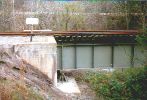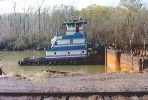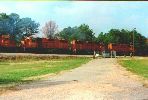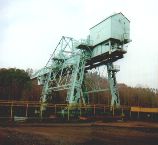Birmingham Southern Railroad
Railfans' Delight
There are lots of great railroad action areas in Birmingham. There is a lot of modern mainline activity downtown in the "railroad reservation". Unlike many cities which were founded along a river, Birmingham was founded at the planned junction of two railroads. The path of the railroads through the center of town was the "railroad reservation", since it was planned that the City and industrial sites would be located along the railroad.
It is hard to believe that these photos are almost 10 years old.
A lot has happened in the last 10 years. One great step forward is a new book about this Birmingham Southern Railroad, written and published locally in Birmingham. The author is Ron Mele, and his book is Birmingham Southern Railroad Company, The First Century. Details are listed in the bibiography section of this website.
Birmingham Southern Birmingport Branch
One of the most interesting areas for train watching is
the operation of the Birmingham Southern which serves the USX steel mill at
Fairfield, on the southwest side of town. Each day there are unit ore
trains which go from the mill to Birmingport, on the Black Warrior River, to
pick up ore pellets, and return to the plant. The following photos are by
the author, and larger images are available as links. I had always been
interested in the ore train operations of the north and it was fun to find them
in the Heart of Dixie.
In the photos above we see the Birmingham Southern train enroute from Fairfield to Birmingport on a spring Sunday morning in 1993. The locomotives are ex-Detroit, Toledo and Ironton, and it takes 4 to move the train. The ore cars are typical short hoppers, and all are second hand judging by the paint schemes.
One of the things that makes Birmingport interesting to me is that the track forms a return loop, which we often see on model railroads, but not so much on the prototype. In the third photo, the train is entering the Birmingport loop. The river and the large loading crane are on the right, and the return part of the loop is on the left. All the action in these photos was taken from the right- of- way or from a driveway. In other words, stay off the railroad's right- of- way unless you have permission. The switch crew reminded us of this, and it was clear that we would not have their permission, which was ok, since they were working and we were sightseeing.
The large crane is operates in two directions:
the "clamshell" bucket moves to and from the river, and the entire
crane can travel parallel to the river. The barges are docked at a
concrete pier, and the tracks are parallel to the river. The clamshell
moves out over the barge, lowers, fills (by closing the jaws), and moves away
from the river. It travels to the land end of the crane where it can lower
and empty into a rail car.
Another feature at the Birmingport area is this bulk
tank farm, which I believe is for asphalt petroleum products. In this
panorama view, looking across Short Creek, the tracks are actually
straight. The loop is to the right, and the City is to the left. In
the background, on the left, is a bridge which crosses Short Creek to allow a
spur track to access the tank facility. The bridge is shown below and is a
great example of a deck plate girder span. It would make a great model, as
would the entire Birmingport facility.
In the panorama shot above, we see the larger view of the Birmingport terminal yard. The river is in the background, where the crane is, and the picture was taken from SR 269, Birmingport Road, in west Jefferson County, Alabama. The ore cars are waiting to be assembled into a train and taken to the mill at Fairfield. You can see that there are a variety of bulk materials stored on the yard, including stone, coal, and salt. The railroad ships coal here as well, although I am not sure if it is inbound or outbound. The last shots show the bridge mentioned above and a "towboat" (not tugboat).
Barges are pushed by these boats (not towed, go figure) and a group of barges has always been called a "tow". My theory on the confusion about "tows" and "towboats" is this: The part of the boat that "pushes" is called a towing "knee", so it is logical that the part in front of and below the knee is the "tow" or "toe". That's my story and I am stickin' to it...
The facility is operated by the Gulf Warrior Navigation
company, which operates a river navigation company on several rivers in Alabama.
 |
 |
 |
 |







